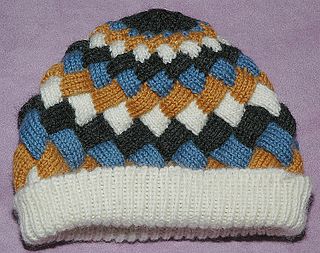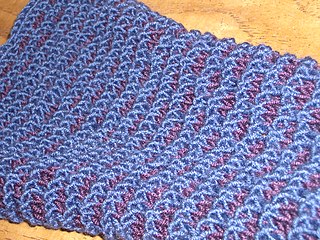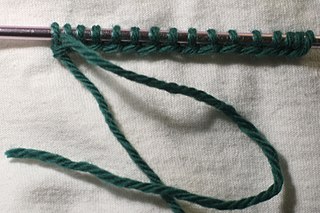Crochet is a process of creating textiles by using a crochet hook to interlock loops of yarn, thread, or strands of other materials. The name is derived from the French term croc, which means 'hook'. Hooks can be made from a variety of materials, such as metal, wood, bamboo, bone or even plastic. The key difference between crochet and knitting, beyond the implements used for their production, is that each stitch in crochet is completed before the next one is begun, while knitting keeps many stitches open at a time. Some variant forms of crochet, such as Tunisian crochet and broomstick lace, do keep multiple crochet stitches open at a time.

Knitting is a method for production of textile fabrics by interlacing yarn loops with loops of the same or other yarns. It is used to create many types of garments. Knitting may be done by hand or by machine.

Filet crochet is a type of crocheted fabric that imitates filet lace. This type of crocheted lace is gridlike because it uses only two crochet stitches: the chain stitch and the double crochet stitch. Old filet patterns used a treble or triple stitch vertically but chained two between the vertical stitches. This was to prevent distortion of some patterns. Chain stitches use less yarn than double crochet stitches, which results in a visual difference in appearance between the two kinds of stitch. Filet crochet forms patterns by filling in parts of a mostly chain stitch mesh with double crochet stitches. Filet crochet is usually constructed from monotone crochet thread made of Mercerised cotton in white or ecru, and worked in rows. Filet crochet is often used for decorative applications, such as window curtains, tablecloths, and place settings, such as coasters and placemats, but can also be used to create clothing, including yokes, as well as accessories and small bags.
The term "gauge" is used in knitting to describe the fineness size of knitting machines. It is used in both hand knitting and machine knitting. The phrase in both instances refers to the number of stitches per inch rather than the size of the finished article of clothing. The gauge is calculated by counting the stitches or needles across a number of inches, then dividing by the sample's width in inches.

Entrelac is a knitting technique used to create a textured diamond pattern. While the result resembles basket-woven strips of knitted fabric, the actual material comprises interconnected squares on two different orientations.

Slip-stitch knitting is a family of knitting techniques that uses slip stitches to make multiple fabrics simultaneously, to make extra-long stitches, and/or to carry over colors from an earlier row.

In knitting, casting on is a family of techniques for adding new stitches that do not depend on earlier stitches, i.e., having an independent lower edge. In principle, it is the opposite of binding off, but the techniques involved are generally unrelated.
The manufacture of textiles is one of the oldest of human technologies. To make textiles, the first requirement is a source of fiber from which a yarn can be made, primarily by spinning. The yarn is processed by knitting or weaving, which turns it into cloth. The machine used for weaving is the loom. For decoration, the process of colouring yarn or the finished material is dyeing. For more information of the various steps, see textile manufacturing.
In knitting, steeking is a shortcut used to knit garments such as sweaters in the round without interruption for openings or sleeves until the end. After completing a tube, a straight line is cut along the center of a column of stitches, in order to make room for an opening or place to attach another piece. The steek itself is a bridge of extra stitches, in which the cut is made, and is usually 6-10 stitches wide. This technique was developed by the knitters of Shetland and is particularly associated with Fair Isle sweaters, although it can be used for solid colors as well.
A knitting club is a social group in which knitting and crochet enthusiasts gather to do needlework together. They are a feature of the 21st-century revival of hand knitting which began in America and has spread to most of Europe. Despite the name, knitting clubs are not limited to knitting; both crochet-centered and knit-centered clubs are collectively called "knitting clubs." While knitting has never gone away completely, this latest reincarnation is less about the make-do and mend of the 1940s and 1950s, and more about making a statement about individuality and developing a sense of community.

In crochet, a stitch marker is a mnemonic device used to distinguish important locations on a work in progress. Crochet patterns have a mathematical basis, so stitch markers serve as a visual reference that takes the place of continuous stitch counting and reduces a crocheter's error rate.

A hook gauge or needle gauge is a measuring device used by crocheters and knitters to test the sizes of particular crochet hooks and knitting needles. Hook gauges are usually made of plastic or aluminum and have sizing holes from 2mm to 11mm diameter. A hook gauge also functions as a ruler to test the size of a test swatch of handmade fabric.

A shell stitch is a crochet motif often used as a border around other patterns or in staggered rows to create a distinctive fabric pattern. Shell stitches take the shape of arcs and semicircles, hence the name. Shell stitches are often used as edging for crocheted items such as Afghan blankets and sweaters.
Hand knitting is a form of knitting, in which the knitted fabric is produced by hand using needles.

Ravelry is a free social networking service and website that beta-launched in May 2007. It functions as an organizational tool for a variety of fiber arts, including knitting, crocheting, spinning and weaving. Members share projects, ideas, and their collection of yarn, fiber and tools via various components of the site.
I Knit London is a knitting organisation based in London, England, UK, comprising a knitting group, knitting shop and knitting events. I Knit London was formed in December 2005, and is run, by Gerard Allt and Craig Carruthers.

Yarn weight refers to the thickness of yarn used by knitters, weavers, crocheters and other fiber artists.

Eisaku Noro Company, Ltd. is a yarn manufacturer located in the Aichi Prefecture of Japan. The company produces yarns for handcrafting under the Noro brand name, as well as machine yarns for textile production using the Eisaku Noro label. The company was founded over forty years ago by Eisaku Noro. The handcrafting yarns in particular are well known for their vivid colors and combinations of diverse fiber types. They differ from a number of other manufactured yarns in the industry by having lengthier spans of color in the runs, causing distinctive striping patterns, as well as being partially spun by hand versus being produced completely by machines. In 2012, Noro Knitting Magazine initiated publication, which features knit and crochet patterns specifically designed for use with the yarns.

Illusion knitting or shadow knitting is a form of textile art, in which the knitting is viewed as simply narrow stripes from one angle, and as an image when viewed from another angle. Illusion knitting has been recognised as an art form since 2010, largely due to the advances made by Steve Plummer who has created several large and detailed pieces. Similar effects occur in Tunisian crochet.















